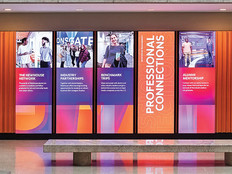Best Practices for Setting Up Higher Ed Digital Signage
Since 2006, I have been involved with video production at West Virginia University, assisting with departmental, athletic and national messaging. In fall 2007, when WVU rolled out digital signage, I was tapped to help shape the solution’s design and feel.
We now have digital signage on approximately 140 screens on three campuses. When setting up a digital signage network across multiple buildings, it’s easiest to break the task down into three main areas: choosing monitors, selecting a content management system, and managing content.
Think Carefully When Choosing a Monitor
One of the easiest parts of the process is selecting a monitor, but several considerations are key. Commercial-grade monitors are best because they are designed to be on every day of the year, around the clock, and they usually have a three-year onsite warranty. Installing a consumer-grade, big-box store monitor in a nonresidential setting will generally void the warranty.
Direct-light LED screens are usually preferred because of their uniform screen brightness. The monitor’s thickness is another consideration: According to the 2010 ADA Standards for Accessible Design, wall-mounted monitors cannot protrude from the wall more than 4 inches if they’re installed at a height of less than 8 feet — a good reason to consider monitors and mounts together.
Develop a System That Works
Deciding which content management solution, video players and content to use is tricky because they all affect one another. However, there are certain things to watch out for:
-
If using an embedded media player on the monitor, there is limited control over how images on a thumb drive will play. There is also an increased likelihood that someone will have to get on a ladder to manually update messages, and the signage system won’t work for emergency messaging.
-
Exclusively web-based content management solutions can be risky if the internet connection isn’t reliable. Stakeholders should be clear on what will happen if the internet signal is lost: Will the screens go black? How much content will be cached?
-
If an Android or other mobile operating system is chosen for the video player, the hardware running the system may not have much storage space to cache data if the internet signal is lost. A Windows-compatible content management solution mitigates this concern. Windows systems, though more expensive and requiring the purchase of a PC, can accommodate a larger hard drive to cache all content and provide better remote management.
When we initialized our network, computers cost about $2,000; today, Intel Core i7 machines are now available for under $700. Using a PC is especially important if messaging will require a lot of video or the solution has multiple-screen video walls running more than 4,000 images.
Content is the single most important thing about a digital signage network. Conversations with stakeholders are vital to identify what type of communication they want on the digital signs.
Create a Content Management Plan
Our small team that administers the signage network could not possibly create all the individual messaging for those screens, so we developed custom web forms that enable communicators in each school or college to put their messaging into a SQL database. This allows them to control the messaging on designated screens across campus.
Around 95 percent of the messaging on our network comes in as live data — a huge factor in selecting a content management solution. The solution we chose had to be able to pull directly from a SQL database.
We have since migrated from a direct SQL pull and instead have created custom XML feeds from those SQL databases. This allows us to share the information in our databases with others in the community so they only have to input the content once, and all the data resides in a centralized location. Members of the university community can also draw on the content for web pages and RSS feeds.








